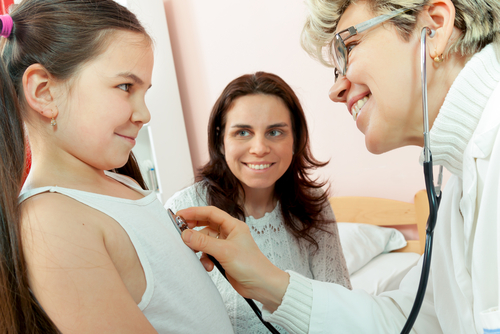 The UK’s National Institute for Health and Care Excellence (NICE), an independent body responsible for driving improvement and excellence in the health and social care system, is developing a new draft guidance of standards and information on Bronchiolitis, a common, and sometimes severe illness that affects the lower respiratory tract and around 1 in 3 babies will develop the condition in their first year of life.
The UK’s National Institute for Health and Care Excellence (NICE), an independent body responsible for driving improvement and excellence in the health and social care system, is developing a new draft guidance of standards and information on Bronchiolitis, a common, and sometimes severe illness that affects the lower respiratory tract and around 1 in 3 babies will develop the condition in their first year of life.
Bronchiolitis is usually caused by a viral infection (Respiratory syncytial virus – RSV – is the most common cause) resulting in the smallest air passages in the lungs, known as bronchioles, becoming inflamed. This reduces the amount of air entering the lungs and causes breathing difficulties. Symptoms usually start as a cough with forced breathing. It often results in difficulty feeding.
According to the National Institution of Health’s Medline reference, Bronchiolitis usually affects children under the age of 2, the peak age being 3 to 6 months. More than half of all infants are exposed to this virus by their first birthday.
Other viruses that can cause bronchiolitis include Adenovirus, Influenza, and Parainfluenza, all of which spread to infants by coming into direct contact with nose and throat fluids of someone who is infected — typically another child or an adult who has a virus who sneezes or coughs nearby atomizing tiny droplets in the air that are then breathed in by the infant, or who touches toys or other objects that are then touched by the infant. Careful hand washing, especially around infants, can help prevent the spread of viruses.
[adrotate group=”3″]
Bronchiolitis occurs more often in the fall and winter than other times of the year, and NIH says it is a very common reason for infants to be hospitalized during winter and early spring.
Risk factors of bronchiolitis include:
• Being around cigarette smoke
• Being younger than 6 months old
• Living in crowded conditions
• Not being breastfed
• Being born before 37 weeks of pregnancy
Bronchiolitis begins as a mild upper respiratory infection, but within 2 to 3 days, the child develops more breathing problems, including wheezing and a cough.
Symptoms may include:
• Bluish skin due to lack of oxygen (cyanosis) — emergency treatment is needed
• Breathing difficulty including wheezing and shortness of breath
• Cough
• Fatigue
• Fever
• Muscles around the ribs sink in as the child tries to breathe in (called intercostal retractions)
• Infant’s nostrils get wide when breathing
• Rapid breathing (tachypnea)
 Professor Mark Baker, NICE’s director of clinical practice, says Bronchiolitis may often be confused with a common cold in infants who present to primary care. In the majority of cases, symptoms are mild and will only last a few days, but in some cases the disease can lead to serious illness. It is therefore very important that children with bronchiolitis be correctly diagnosed and their symptoms closely monitored, so parents and carers, as well as doctors, nurses and health visitors need to know when to seek help from specialist care.
Professor Mark Baker, NICE’s director of clinical practice, says Bronchiolitis may often be confused with a common cold in infants who present to primary care. In the majority of cases, symptoms are mild and will only last a few days, but in some cases the disease can lead to serious illness. It is therefore very important that children with bronchiolitis be correctly diagnosed and their symptoms closely monitored, so parents and carers, as well as doctors, nurses and health visitors need to know when to seek help from specialist care.
Most children with bronchiolitis can be managed at home and the draft guideline has key safety information for parents and carers. This includes red flag symptoms to look out for such as increasing difficulty breathing or exhaustion, and when to arrange a follow up or get immediate help.
The NICE guideline sets out the symptoms which require immediate referral to emergency care, usually by calling 999 in the UK or 911 in the US and Canada. Urgent symptoms include stopping breathing, looking seriously unwell or beginning to turn blue.
The NIH says to contact your health care provider right away or go to the emergency room if the child:
• Becomes extremely tired
• Has bluish color in the skin, nails, or lips
• Starts breathing very fast
• Has a cold that suddenly worsens
• Has difficulty breathing
• Has nostril flarings or chest retractions when trying to breathe
Approximately one in five infants will develop clinical Bronchiolitis in the first year of life and 2-3% of all infants with Bronchiolitis will require hospitalization. In 2011/12 there were 30,451 secondary care admissions for Bronchiolitis, and in 2009/10 there were 72 recorded deaths of children within 90 days of hospital admission for Bronchiolitis in England.
The NICE guideline sets out recommendations for people working in primary care on when to consider referral to specialist care, such as if a child has rapid breathing (a respiratory rate of over 60 breaths/minute), difficulty breastfeeding or clinical dehydration. It also recommends treatment with supportive therapies such as oxygen, airway suctioning or tube feeding for some children with bronchiolitis. It does not recommend the use of a range of other therapies such as antibiotics, bronchodilators or corticosteroids. Antibiotics do not work against viral infections. The NIH says a medicine called palivizumab (Synagis) that boosts the immune system may be recommended for certain children.
For care at home, the NIH recommends that the child:
• Drinks plenty of fluids. Breast milk or formula is okay for children younger than 12 months. Electrolyte drinks, such as Pedialyte, are also okay for infants.
• Breathe moist air to help loosen sticky mucus. Use a humidifier to moisten the air.
• Get plenty of rest.
Also, do not allow anyone to smoke in the house, car, or anywhere near the child. Children who are having trouble breathing may stay in the hospital. Treatment there may need oxygen therapy and fluids given through a vein (IV). Breathing often gets better by the third day and symptoms typically mostly clear within a week. In rare cases, pneumonia or more severe breathing problems develop, and some children may develop problems with wheezing or asthma as they get older.
“With this new draft guideline our aim is to assist clinicians, alongside parents and carers, in making decisions about how to thoroughly assess babies and young children with bronchiolitis and what the most appropriate treatments are to use, to ensure they are well looked after,” Prof. Baker notes.
The NICE draft guideline on Bronchiolitis will be open for public consultation until Monday 5 January 2015. Although only registered stakeholders (such as professional and government organizations, patient and carer groups and companies) can formally comment on NICE consultations, organizations can register as a stakeholder at any time during the development of a guideline. Individuals are advised to pass comments through the registered stakeholder organization that most closely represents them.
The draft guidance for bronchiolitis in children is available at:
http://www.nice.org.uk/guidance/indevelopment/GID-CGWAVER136
The final guideline is due to be published in May 2015.
Sources:
National Institute for Health and Care Excellence (NICE)
National Institution of Health MedlinePlus Medical Encyclopedia
Image Credit:
National Institute for Health and Care Excellence (NICE)

